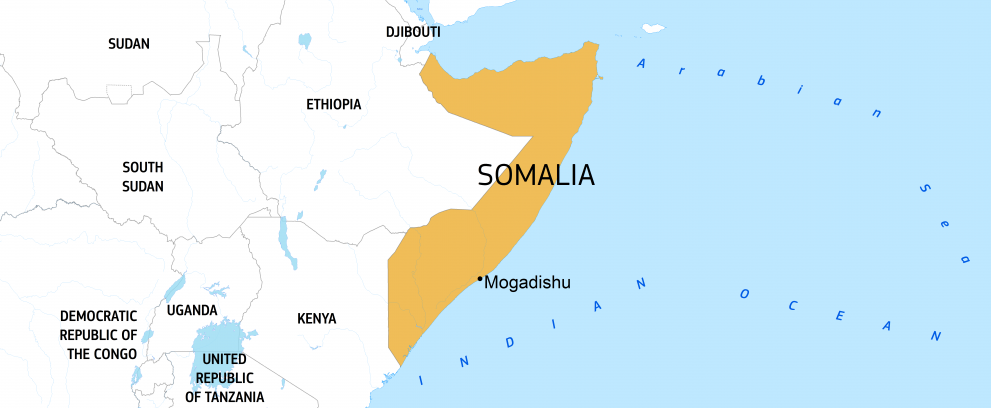Introduction
For decades, Somalia has endured prolonged conflict and extreme weather conditions.
The 2020-2023 drought—the result of 5 consecutive failed rain seasons—caused 90% of the country to be under extreme conditions and impacted over 8 million people.
The 2023 Deyr rainy season (October-December), aggravated by the El Niño effect, translated into above-average rainfalls and massive flooding, affecting 2.5 million people, including 1.2 million who were forcibly displaced.
Somalia is currently hit by La Niña, which is projected to impact the country until mid-2025 at least. This is causing dry spells and below-average rains, which will heighten food insecurity, cholera, and waterborne diseases and intensify resource-based conflict among clans.
What are the needs?
47% of the population in Somalia is affected by conflict, floods, drought, disease outbreaks and displacement, causing humanitarian needs. In 2025, 6 million people are in extreme need of urgent, lifesaving humanitarian assistance and protection.
While food is ranked first among households’ priority needs, half of Somalia’s population is water insecure, and suitable living spaces remain challenging. Access to adequate health care continues to be limited, particularly in rural and underserved areas. Displaced communities are particularly exposed to vulnerabilities.
4.6 million people are acutely food insecure, and 1.8 million children under the age of 5 are expected to be severely malnourished by the end of 2025.
Conflict and extreme climate events are projected to cause forced displacement on a similar scale to 2024 in 2025.

Currently, there are close to 4 million internally displaced people in Somalia due to drought, floods, conflict, and insecurity. They live in unsanitary makeshift camps, facing increased protection and health risks.
Since 2022, protracted armed conflict with renewed large-scale fighting has severely impacted civilians and the movement of people and goods in the country. Violations of international humanitarian law are widespread.
Therefore, increased humanitarian assistance is needed to respond to the number of overlapping crises and prevent excessive mortality.
The 2025 Humanitarian Needs and Response Plan for Somalia requires US$1.42 billion to meet the priority needs of the 5.98 million people targeted.

How are we helping?
The EU’s initial 2025 allocation for Somalia stands at €36 million. In 2024, the EU allocated €82.16 million for humanitarian interventions in the country. In 2023, the EU allocated €84.38 million for humanitarian projects in Somalia, mainly in response to the drought.
EU humanitarian funding supports aid organisations in delivering (i) food assistance, (ii) basic health and nutrition services, (iii) clean water, (iv) protection, (v) shelter, and (vi) education.
Our humanitarian partners work in rural and hard-to-reach areas to ensure no one is left behind. They also work to mitigate further displacement of rural populations while providing essential lifesaving assistance in already congested urban and peri-urban areas hosting those displaced.

Whenever relevant, EU humanitarian support helps people in need through cash transfers. This enables them to feed and sustain their family while also meeting other basic needs in a dignified way. Using cash transfers also helps overcome accessibility challenges while supporting local markets.
Somalia has high child and maternal mortality rates, severe malnutrition rates, and frequent outbreaks of diseases. The country’s health system faces critical shortages, and only 1/3 of the existing health facilities are functional.
There currently is an increase in disease outbreaks in the country, especially cholera, acute watery diarrhoea, and suspected measles. This is due to climate shocks, limited access to clean water and hygiene, and unsanitary living conditions in displacement camps. All these diseases are potentially deadly.
Therefore, the EU focuses on providing quality health care, epidemic prevention and control, and emergency treatment of malnutrition. We support experienced health and nutrition partners in communities and health facilities.
In July 2022, the EU launched a Humanitarian Air Bridge to deliver emergency supplies to hard-to-reach areas no longer accessible by road. This operation transported life-saving nutrition and health assistance to underserved and hard-to-reach locations during the most critical dry period.
The EU also funds disaster preparedness activities addressing risk from a multi-hazard perspective. The aim is to reduce the impact of the multiple shocks experienced in country related to climate, conflict, and epidemics.
However, Somalia still needs more long-term development assistance to support the resilience and self-reliance of vulnerable individuals, such as pastoral, agricultural and marginalised communities. Cooperation between EU’s humanitarian and development actions are ongoing, especially for cash-based social safety nets and education, to build up the longer-term resilience of affected Somali communities.
Last updated: 14/04/2025
Facts & figures
At least 5.98 million people are in extreme need of humanitarian assistance and 4.6 million are projected to be acutely food insecure by June 2025 (OCHA and IPC March 2025)
1 in 8 children dies before turning 5 (UNICEF)
Close to 4 million internally displaced people (OCHA)
More than 714,000 Somali refugees in neighbouring countries (UNHCR)
EU humanitarian funding:
€36 million in 2025
€82.16 million in 2024
€84.38 million in 2023
€348.6 million since the beginning of 2021
More than €660 million since 2017

